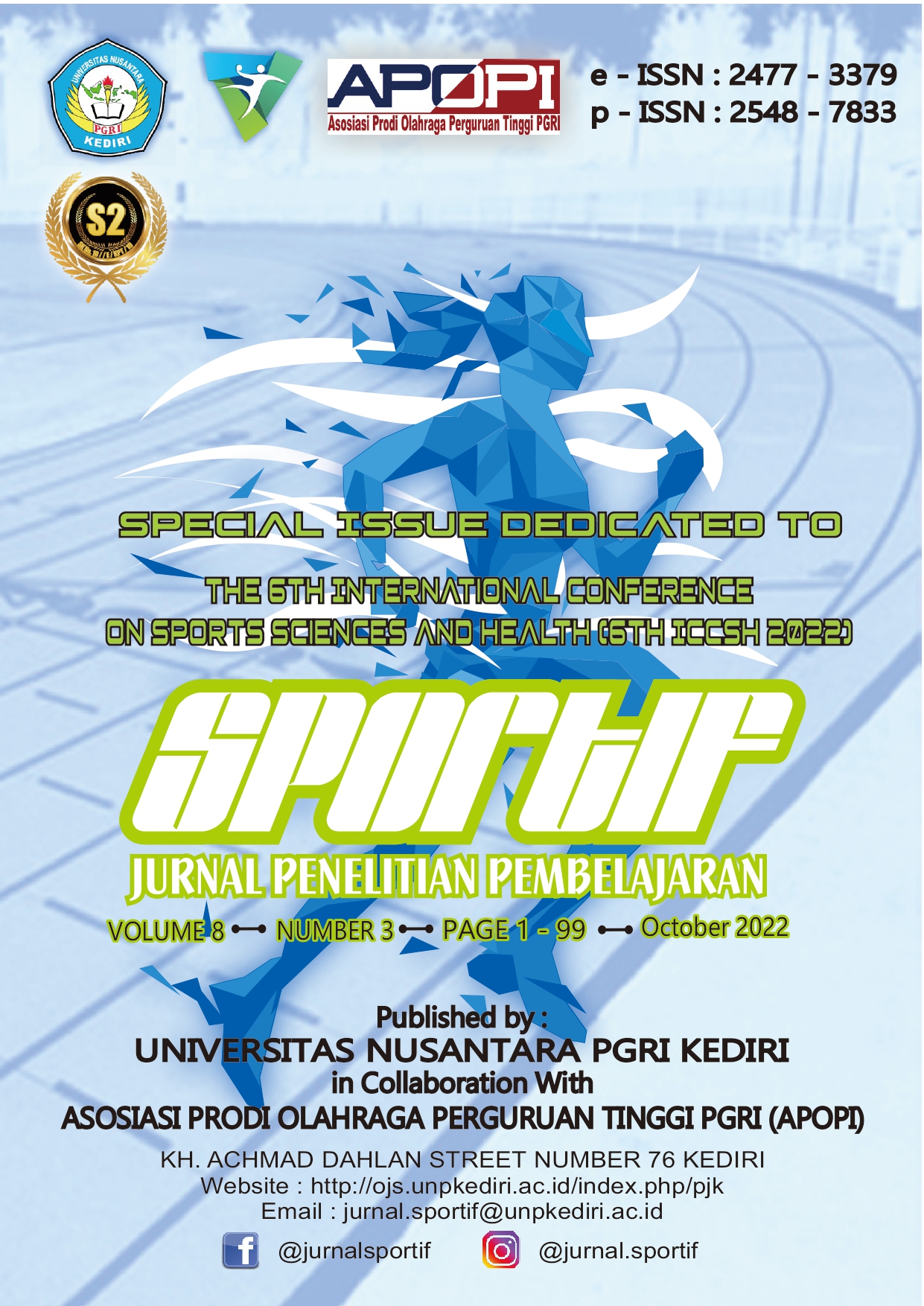Abstrak
Penelitian ini bertujuan untuk mengetahui hubungan antara status gizi siswa dengan hasil belajar, khususnya pendidikan jasmani pada SMP di Kota Bandung, Provinsi Jawa Barat. Penelitian yang digunakan adalah korelasional. Populasi penelitian ini berjumlah 98.289 mahasiswa. Pengambilan sampel menggunakan teknik simple random sampling. Sampel penelitian berjumlah 1870 mahasiswa. Penelitian ini menggunakan data primer yang diperoleh dari pengukuran status gizi siswa dan data sekunder dari guru pendidikan jasmani di Bandung. Alat pengumpulan data mengukur status gizi berdasarkan indeks massa tubuh dan hasil belajar dengan nilai siswa dari guru. Data dianalisis dengan statistik korelasional melalui proses komputerisasi menggunakan program SPSS. Dari hasil penelitian dapat disimpulkan bahwa tidak ada hubungan yang signifikan antara status gizi dengan hasil belajar baik untuk siswa laki-laki maupun perempuan di SMP. Penelitian lebih lanjut dengan mengkaji faktor-faktor lain yang berhubungan dengan BMI dan faktor-faktor lain yang berhubungan dengan hasil belajar, seperti faktor sosial ekonomi dan keluarga.
Referensi
Abdel-Aziz, E. A., Hamza, R. T., Youssef, A. M., & Mohammed, F. M. (2014). Health related quality of life and psychological problems in Egyptian children with simple obesity in relation to body mass index. Egyptian Journal of Medical Human Genetics, 15(2), 149–154. https://doi.org/10.1016/j.ejmhg.2014.01.002
Boukrim, M., Obtel, M., Kasouati, J., Achbani, A., & Razine, R. (2021). COVID-19 and confinement: Effect on weight load, physical activity and eating behavior of higher education students in southern Morocco. Annals of Global Health, 87(1), 1–11. https://doi.org/10.5334/aogh.3144
Cavuoto Petrizzo, M., Block, L., Olvet, D. M., Sheridan, E. M., Dougherty, R., Whitson, M., John, J. T., Barilla-LaBarca, M. L., DiFiglia-Peck, S., & Fornari, A. (2021). Implementation of an Interprofessional Nutrition Workshop to Integrate Nutrition Education into a Preclinical Medical School Curriculum. Journal of the American College of Nutrition, 40(2), 111–118. https://doi.org/10.1080/07315724.2020.1737985
D’Angelo, S. (2019). Polyphenols and Athletic Performance: A Review on Human Data. Plant Physiological Aspects of Phenolic Compounds, 1–23. https://doi.org/10.5772/intechopen.85031
de Brauw, A., Eozenou, P., & Moursi, M. (2015). Programme Participation Intensity and Children’s Nutritional Status: Evidence from a Randomised Control Trial in Mozambique. Journal of Development Studies, 51(8), 996–1015. https://doi.org/10.1080/00220388.2015.1018907
Galasso, E., & Umapathi, N. (2009). Improving nutritional status through behavioural change: Lessons from Madagascar. Journal of Development Effectiveness, 1(1), 60–85. https://doi.org/10.1080/19439340902727669
Grebener, B. L., Barth, J., Anders, S., Beißbarth, T., & Raupach, T. (2021). A prediction-based method to estimate student learning outcome: Impact of response rate and gender differences on evaluation results. Medical Teacher, 43(5), 524–530. https://doi.org/10.1080/0142159X.2020.1867714
Irawan, V. T., Sutadji, E., & Widiyanti. (2017). Blended learning based on schoology: Effort of improvement learning outcome and practicum chance in vocational high school. Cogent Education, 4(1). https://doi.org/10.1080/2331186X.2017.1282031
Kupolati, M. D., Gericke, G. J., Macintyre, U. E., Ferreira, R., Fraser, W., Toit, P. Du, Kupolati, M. D., Gericke, G. J.,
Macintyre, U. E., & Ferreira, R. (2016). Nutrition Education Practices of Primary School Teachers in a Resource-Constrained Community in Gauteng , South Africa Nutrition Education Practices of Primary School Teachers. 0244(May). https://doi.org/10.1080/03670244.2016.1161615
Li, J., Han, S. hyun, & Fu, S. (2019). Exploring the relationship between students’ learning styles and learning outcome in engineering laboratory education. Journal of Further and Higher Education, 43(8), 1064–1078. https://doi.org/10.1080/0309877X.2018.1449818
Lorente, L. M. (2017). Implementation of Early Childhood Physical Activity Curriculum (SPARK) in the Central Valley of California (USA). Procedia - Social and Behavioral Sciences, 237(June 2016), 319–325. https://doi.org/10.1016/j.sbspro.2017.02.097
Machefer, G., Groussard, C., Zouhal, H., Vincent, S., Youssef, H., Faure, H., Malardé, L., & Gratas-Delamarche, A. (2007). Nutritional and plasmatic antioxidant vitamins status of ultra endurance athletes. Journal of the American College of Nutrition, 26(4), 311–316. https://doi.org/10.1080/07315724.2007.10719616
Mbhatsani, V. H., Mbhenyane, X. G., & Mabapa, S. N. (2017). Development and Implementation of Nutrition Education on Dietary Diversification for Primary School Children. Ecology of Food and Nutrition, 56(6), 449–461. https://doi.org/10.1080/03670244.2017.1366319
Narayanan, R., & Rao, N. (2019). Adult learning for nutrition security: Challenging dominant values through participatory action research in Eastern India. Studies in the Education of Adults, 51(2), 213–231. https://doi.org/10.1080/02660830.2019.1573782
Nkhoma, O. W. W., Duffy, M. E., Davidson, P. W., Cory-Slechta, D. A., McSorley, E. M., Strain, J. J., & O’Brien, G. M. (2013). Nutritional and cognitive status of entry-level primary school children in Zomba, rural Malawi. International Journal of Food Sciences and Nutrition, 64(3), 282–291. https://doi.org/10.3109/09637486.2012.746287
Økland, G. M. (2012). Determinants of Learning Outcome for Students at High School in Norway: A Constructivist Approach. Scandinavian Journal of Educational Research, 56(2), 119–138. https://doi.org/10.1080/00313831.2011.568622
Shi, X., Tubb, L., Chen, S., Fulda, K. G., Franks, S., Reeves, R., & Lister, G. (2014). Associations of health disparities and physical activity with children’s health and academic problems. Journal of Exercise Science and Fitness, 12(1), 7–14. https://doi.org/10.1016/j.jesf.2013.12.003
Som, S., Pal, M., & Bharati, P. (2007). Role of individual and household level factors on stunting: A comparative study in three Indian states. Annals of Human Biology, 34(6), 632–646. https://doi.org/10.1080/03014460701671772
Soriano, T. T., Eslick, G. D., & Vanniasinkam, T. (2018). Long-Term Nutritional Outcome and Health Related Quality of Life of Patients Following Esophageal Cancer Surgery: A Meta-Analysis. Nutrition and Cancer, 70(2), 192–203. https://doi.org/10.1080/01635581.2018.1412471
Tariku, A., Belew, A. K., Gonete, K. A., Hunegnaw, M. T., Muhammad, E. A., Demissie, G. D., Biks, G. A., Awoke, T., Gelaye, K. A., Zeleke, E. G., Abebe, Z., Gete, A. A., Yesuf, M. E., Abebe, S. M., Gete, Y. K., Gelagay, A. A., Fekadu, A.,
Muchie, K. F., & Wassie, M. M. (2019). Stunting and Its Determinants among Adolescent Girls: Findings from the Nutrition Surveillance Project, Northwest Ethiopia. Ecology of Food and Nutrition, 58(5), 481–494. https://doi.org/10.1080/03670244.2019.1636793
Upadhyay, S., Kumar, A. R., Raghuvanshi, R. S., & Singh, B. B. (2011). Nutritional Status and Knowledge of Hill Women on Anemia: Effect of Various Socio-demographic Factors. Journal of Human Ecology, 33(1), 29–34. https://doi.org/10.1080/09709274.2011.11906346
Verburgh, L., Scherder, E. J. A., Van Lange, P. A. M., & Oosterlaan, J. (2016). Do elite and amateur soccer players outperform non-athletes on neurocognitive functioning? A study among 8-12 year old children. PLoS ONE, 11(12), 1–12. https://doi.org/10.1371/journal.pone.0165741
Wallhead, T. L., Hastie, P. A., Harvey, S., & Pill, S. (2021). Academics’ perspectives on the future of sport education. Physical Education and Sport Pedagogy, 26(5), 533–548. https://doi.org/10.1080/17408989.2020.1823960
##submission.copyrightStatement##


